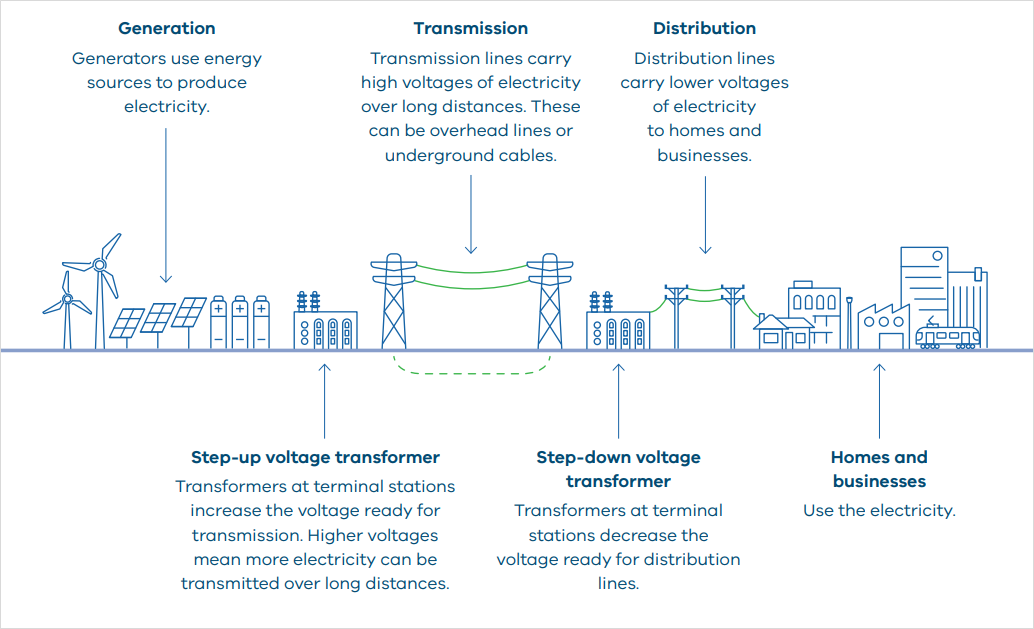On this page:
The grid is the complex network that carries electricity from generators to homes and businesses.
Generators use energy sources like coal, wind or solar to produce electricity. The electricity is converted to a higher voltage at terminal stations at the beginning of the network and transported over long distances.
The electricity is then converted to a lower voltage at terminal stations at the end of the transmission network. From here electricity is transported to homes and businesses across the state by the distribution network. These are the poles and wires that we see along our streets.
Why do we need new transmission lines?
We need to build new transmission lines to connect new renewable energy sources to the grid.
Victoria’s current energy grid was built last century. It was designed to connect coal-fired power generators in the Latrobe Valley to Victorian homes and businesses. These coal-fired power stations are now coming to the end of their economic life and are set to close in the coming decades.
This means that we need to change where we get our energy from. At the same time, the electrification of vehicles, homes, offices and industries means there will be more demand for electricity in the future.
Victoria is replacing its ageing coal-fired power generators with renewable energy sources like solar and wind. These renewable energy sources are spread across the state and are not always located close to existing transmission infrastructure.
That's why we are working on networks upgrades, including new transmission lines, so that more renewable energy can flow to where it is needed across Victoria.
Transmission technologies
Making the right decisions about the best technologies to use is an important part of building new energy infrastructure.
For an in-depth look into how each transmission type is constructed, operated and maintained, read our summary of transmission infrastructure factsheet.
Overhead and underground transmission
Making the right decisions about the best technologies to use is an important part of building new energy infrastructure.
Both overhead transmission lines and underground cables have advantages and disadvantages to consider when planning transmission projects. Most of the transmission infrastructure around the world uses overhead lines.
While overhead lines may have visual impacts, they have better power transfer capacity, are easier to maintain, cost less to build and more easily allow for the connection of new generation and storage along the line.
Underground lines can sometimes be the preferred solution, for example, where no additional connections are needed or where overhead is not possible because of the terrain. However, underground cables also have greater environmental and land use impacts, can be technically challenging, and are considerably more expensive.
For more information, read our overhead and underground transmission factsheet.
Batteries and energy storage
As Victoria transitions to a cleaner, more reliable energy future, battery energy storage systems (BESS), also known as grid-scale batteries, are playing a vital role in modernising the grid. These systems store electricity generated from renewable sources, providing rapid-response backup during supply disruptions and stabilising the grid during frequency imbalances.
Strategically deployed in renewable energy zones, BESS enhances grid security and helps to deliver affordable energy during peak demand. For more information, visit the batteries and energy storage page on the Energy Victoria website.
Syncline community cable assessment
VicGrid has advised Syncline Energy their proposal will not be included in the 2025 Victorian Transmission Plan.
Expert analysis found the current Syncline proposal:
- includes risks and challenges that are likely to extend the proposal's timeline for delivery and increase costs significantly
- would cost substantially more than the Western Renewables Link (WRL). Any increase in costs will directly impact Victorians through higher energy bills
- would be completed later than WRL, with significant risks of the timeline being extended due to construction challenges
- would face large additional costs to connect renewable energy projects to the proposed direct current underground line, compared to WRL
- would result in significant disruptions along the Calder Freeway during construction for extended periods of time.
VicGrid's assessment was completed with the support of technical experts North Projects, Clayton Utz, KPMG, and AECOM.
More information
The Energy Victoria website provides information about the infrastructure to support the transition to renewable energy, including battery storage, solar and wind energy.
Page last updated: 29/10/25


